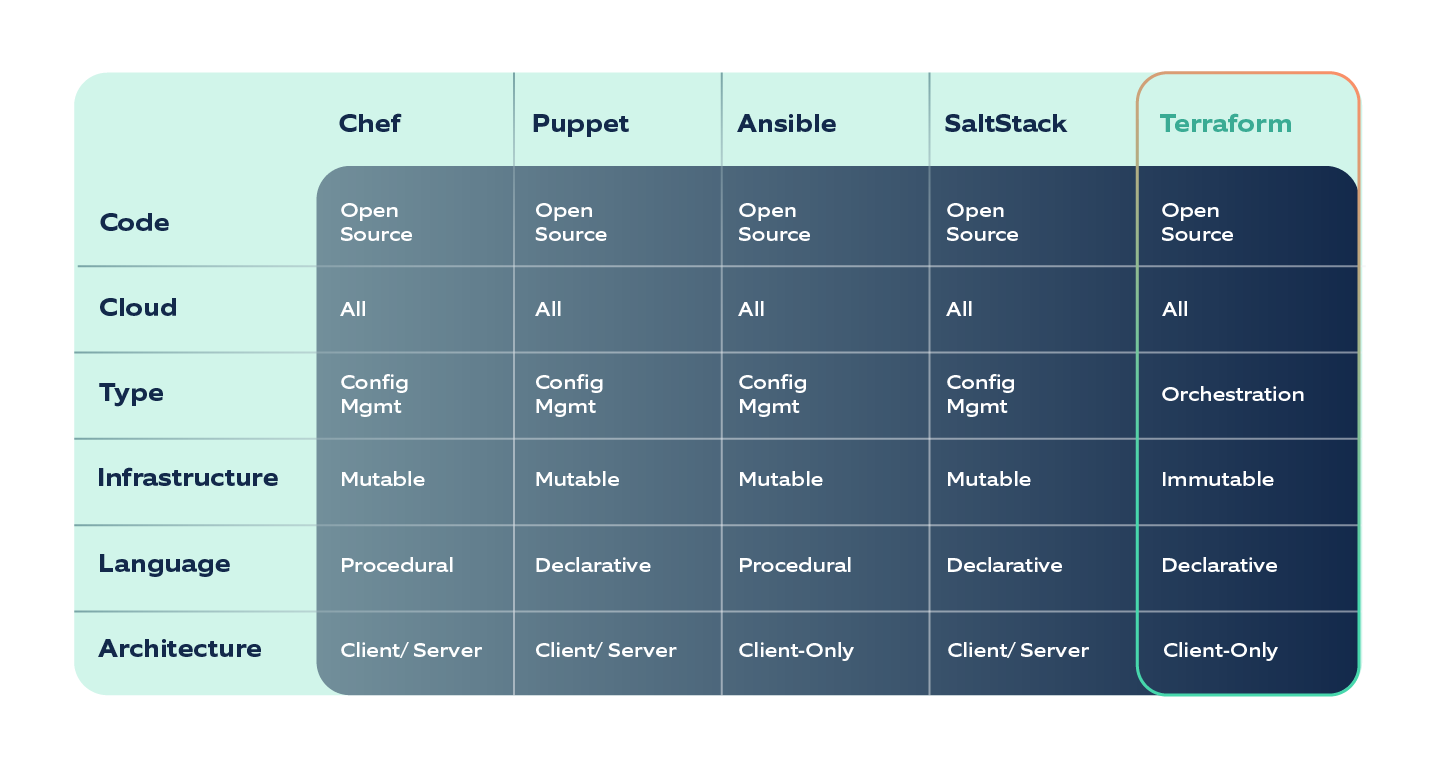In today’s fast-paced world of technology and cloud computing, the demand for infrastructure automation has grown exponentially. Organizations are constantly striving to reduce operational overhead, increase agility, and ensure the consistency and reliability of their infrastructure. Enter Infrastructure as Code (IaC) with Terraform, a revolutionary approach that has reshaped the way we manage and deploy infrastructure in the cloud.
What is Infrastructure as Code (IaC)?
Infrastructure as Code is a paradigm shift that treats infrastructure in the same way as software code. Just as software developers use code to automate the deployment and management of applications, infrastructure engineers use code to automate the provisioning, configuration, and management of infrastructure resources. This approach brings several advantages:
- Version Control and Collaboration: IaC code is typically kept in version control systems (e.g., Git, Gitlab, Bitbucket), enabling teams to track changes, collaborate on infrastructure code, and roll back to older version if required. This promotes consistency and transparency across the organization.
- Reusability: IaC code can be modularized, allowing the reuse of infrastructure components across different projects and environments. This reduces duplication of effort and accelerates development.
- Scalability: As infrastructure code is written, it can be easily adapted to accommodate growth and scaling requirements. Whether you're deploying one virtual machine or a thousand, the process remains the same, ensuring predictability and reliability.
- Documentation: IaC code helps to be the documentation for your infrastructure. Anyone can review the code to understand the architecture and configuration, making it easier to troubleshoot issues and onboard new team members.
Introducing Terraform
Terraform, developed by HashiCorp, is one of the most popular IaC tools available today. It is an open-source infrastructure provisioning and configuration tool, allowing you to define and create infrastructure resources using a declarative configuration language.
Key concepts in Terraform
- Providers: Providers are plugins that interact with various cloud and infrastructure providers (e.g., AWS, Azure, Google Cloud, VMware). Terraform uses providers to communicate with these platforms and provision resources.
- Resources: Resources represent essential infrastructure components, such as virtual machines, networks, databases, and more. You define resources in your Terraform configuration, specifying their characteristics and dependencies.
- Modules: Modules are reusable packages of Terraform configurations that can be used to encapsulate and share infrastructure components. They allow you to abstract and modularize your infrastructure code for easier management.
- State: Terraform maintains a state file that tracks the current state of the infrastructure. This state file helps Terraform understand the relationships between resources and plan updates accordingly.
Blog author Aditya Gupta in our "Let's talk DevOps" - video talk show on the topic of IaC with Terraform
The Terraform Workflow

The typical Terraform workflow consists of three main steps:
- Initialization: Run terraform init to initialize a Terraform configuration in a directory. This step downloads the necessary provider plugins and sets up the environment for Terraform.
- Planning: Execute terraform plan to create an execution plan. Terraform analyzes the current state of your infrastructure, compares it to your desired state defined in the configuration, and generates an execution plan outlining the necessary changes.
- Application: Finally, run terraform apply to make the changes defined in the execution phase/plan. Terraform will automatically apply the required changes to align your infrastructure with the desired state.
Optional steps:
- Validate: You can use terraform validate to check the validity of your Terraform configuration files without actually applying them to your infrastructure.
- Destroy: You can also use terraform destroy to destroy and tear down the infrastructure resources managed by your Terraform configuration.
Advantages of using Terraform for IaC
Terraform offers numerous advantages for managing infrastructure as code:
- Multi-Cloud Support: Terraform is provider-agnostic, meaning it can be used with various cloud providers and on-premises solutions. This flexibility allows organizations to adopt a multi-cloud strategy or migrate between providers with ease.
- Declarative Syntax: Terraform uses a declarative configuration language that defines "what" you want your infrastructure to look like, rather than "how" to achieve it. This makes it easier to read and understand, even for non-developers.
- Immutable Infrastructure: With Terraform, infrastructure changes are managed as code updates. This promotes the concept of immutable infrastructure, where changes are made by provisioning entirely new resources rather than modifying existing ones. This method lessens the risk of configuration drift and simplifies rollback processes.
- Collaboration and Code Reusability: Terraform's code-centric approach encourages collaboration among teams and the sharing of reusable modules. This promotes best practices and accelerates development cycles.
- Scalability and Automation: Terraform allows for the dynamic provisioning of resources, making it ideal for handling large-scale deployments and autoscaling. It integrates good enough with CI/CD pipelines, enabling fully automated infrastructure deployment.
Real-world use cases
Terraform has found widespread adoption in various industries and use cases:
- Cloud-Native Applications: Organizations building cloud-native applications rely on Terraform to create infrastructure resources, such as containers, virtual machines, and serverless functions, in a consistent and automated manner.
- DevOps and CI/CD: Terraform is a crucial tool in DevOps practices, enabling teams to automate the creation of development, testing, and production environments as part of a CI/CD pipeline.
- Hybrid Cloud: Companies with hybrid cloud environments leverage Terraform to manage resources both in the cloud and on-premises. This allows for seamless integration between private data centers and public cloud providers.
- Infrastructure Migration: Terraform simplifies the process of migrating from on-premises data centres to the cloud or between cloud providers. The ability to define infrastructure as code facilitates a smooth transition.
Best practices
To harness the full power of Terraform, consider these best practices:
- Organize Your Code: Structure your Terraform code into meaningful directories and modules. This makes your codebase more maintainable and promotes code reuse.
- Use Variables and Data Sources: Leverage variables and data sources to parameterize your configurations and make them more flexible. This allows you to reuse configurations across environments with minimal changes.
- Implement Version Control: Store your Terraform code in a VCS (version control systems) like GitHub, Bitbucket, etc. to track changes, collaborate effectively, and ensure a history of your infrastructure changes.
- Automate Testing: Implement automated testing for your Terraform code using tools like terraform validate and tflint to catch errors and inconsistencies early in the development process.
- Secure Your Secrets: Use a secrets management tool to securely keep and reclaim sensitive/confidential information such as API keys and passwords. Terraform provides mechanisms for managing secrets.
Challenges
While Terraform offers numerous benefits, there are also challenges to consider. Despite these challenges, Terraform remains a robust and popular tool for infrastructure management, offering valuable benefits in terms of consistency, automation, and infrastructure as code practices. Overcoming these challenges often involves adopting best practices, careful planning, and continuous learning.
Complex Configurations, especially if infrastructure complexity grows, Terraform configurations can become intricate and challenging to manage. Best practices in code organization and modularization are crucial to address this challenge.
- Parallelism and Resource Dependencies: Terraform attempts to create and update resources in parallel, which can lead to issues when resources have dependencies on each other. Understanding and managing resource dependencies can be challenging. Ensuring the correct order of resource creation and management is critical to avoid errors.
- License: Terraform is now under the Business Source License (BSL). The BSL is a non-open-source license, which means that it is not free to use for commercial purposes. This change could make it more difficult and expensive for organizations to use Terraform in production environments.
Terraform Vs Others
Terraform has been instrumental in simplifying infrastructure management in cloud environment. It has come against/with other IaC tools like AWS CloudFormation, Azure Resource Manager (ARM) Templates, Google Cloud Deployment Manager, Pulumi, Troposphere, etc.
There are a lot of IaC (Infrastructure as Code) tools available in the market like Chef, Puppet, Ansible and SaltStack but which one to pick for the automation of your cloud resources.
Chef, Puppet, SaltStack and Ansible are all CM (configuration management) tools, Terraform is a provisioning tool that is designed to provision the servers as well as the rest of the infrastructure, like load balancers, storage, databases, networking conf, etc. This leaves the task of configuring those provisioned servers to other (configuration management) tools that are specifically designed to install as well as manage software on existing servers.

We can also use a configuration management and provisioning tool together. For example, using Terraform to provision your servers while running Chef, Ansible, Puppet to configure them.
Recent developments
On September 20, 2023, the Linux Foundation announced the formation of OpenTofu, an open-source alternative to Terraform's widely used infrastructure as code provisioning tool. Previously named OpenTF, OpenTofu is an open and community-driven response to Terraforms recently announced license change from a Mozilla Public License v2.0 (MPLv2) to a Business Source License v1.1, providing everyone with a reliable, open-source alternative under a neutral governance model.
Conclusion
Infrastructure as Code with Terraform has revolutionized the way organizations manage and deploy their infrastructure. With its flexibility, scalability, and automation capabilities, Terraform empowers teams to provision and manage infrastructure resources efficiently, ensuring consistency and reliability across cloud environments. By embracing Terraform and the principles of IaC, businesses can move more quickly towards digital transformation and maintain their competitiveness in the dynamic world of technology.





